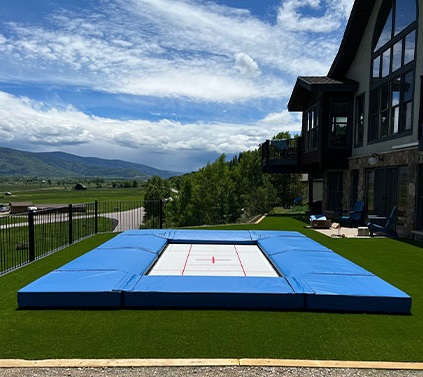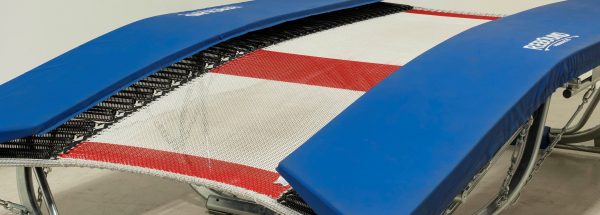More Articles...
You’ll find that competition trampolines come in various sizes and types, each designed for specific disciplines and skill levels. The standard 10×17 foot model is just the beginning. There’s a whole world of specialized equipment available, from synchronized trampolines for pair events to double mini trampolines for complex acrobatic sequences.
As you explore the options, you’ll need to contemplate factors like frame construction, bed material, and safety features. Understanding these differences is vital for both athletes and coaches seeking to optimize performance and safety. But what about the less common trampoline variations? Let’s examine some intriguing alternatives.
Key Takeaways
- Standard competition trampoline dimensions are 10′ x 17′ frame
- Olympic-standard trampolines use a 7×14 surface area for acrobatic manoeuvres.
- Competition trampolines include standard, synchronized, double mini trampoline (DMT), and tumbling types.
- Trampoline beds have evolved from solid nylon to webbing and string beds for improved performance.
- Competition trampolines must meet specific regulations for frame material, spring count, and safety features.
Learn More: Different Competition Trampoline Sizes and Types?
Institutional Trampoline Sizes
When considering acrobatic trampolines, you’ll find two common frame sizes: 10’ x 17’ and 9’x 15’
The 10’ x17’ frame is popular in club settings, offering a balance between bounce quality
Many athletes prefer the 10′ x 17′ frame, which is the Olympic standard, for competitive environments because it offers improved safety and performance to keep the athlete in control while they accomplish their routine.
9′ x 15′ frame
In smaller facilities where space is a premium, the 9′ x 15′ frame trampoline offers an ideal balance of bounce performance and space efficiency. This size is commonly used in club environments, where it generates significant bounce without taking up the space a 10’x17’ trampoline does. This makes it suitable for users of all ages and skill levels.
The 9′ x 15′ frame’s smaller footprint compared to competition-sized trampolines allows for a more efficient use of space. This translates to increased revenue potential per square foot for facility operators. Despite its compact size, you won’t sacrifice bounce quality. The design generates power comparable to that of larger competition trampolines, ensuring a satisfying experience for users.
If you’re looking for even more power in a similar footprint, consider the Rebound 6′ x 12′ string bed. It produces a bounce comparable to that of competition trampolines while maintaining a smaller overall size. This option is particularly useful when space is at a premium but high-performance bouncing is still desired.
10′ x 17′ frame
Moving up in size from the 9′ x 15′ frame, you’ll find the 10′ x 17′ frame as the standard Olympic-sized trampoline. This larger frame offers significant benefits for competitive athletes.
With its increased surface area, you’ll have more room to perform and achieve greater heights in your routines.
The 10′ x 17′ frame is used in competitions worldwide, making it the preferred size for competitive trampoline clubs. You’ll notice that this larger target area provides a greater sense of security, allowing you to focus on perfecting your techniques.
When you’re training on a 10′ x 17′ trampoline, you’re preparing yourself for the exact conditions you’ll face in international competitions. This consistency is pivotal for developing muscle memory and spatial awareness specific to the competition environment.
The larger frame also accommodates more powerful rebounds, enabling you to reach higher altitudes and execute more challenging routines. As you progress in your trampoline career, you’ll appreciate the performance capabilities that this Olympic size provides, helping you push the boundaries of your athletic potential.
Learn More: Trampolines in Canada: Everything You Need to Know

Customized Fabrications
Customized trampoline fabrications cater to specific requirements, offering unique sizes and configurations for various applications. You’ll find that a 10′ x 15′ frame provides an economical, smaller footprint while maintaining a smooth bounce. This size is ideal for facilities with limited space that still need high-performance equipment.
For professional show athletes, an 11′ x 17′ frame is often preferred, especially for wall tramp setups. The wider frame creates a smoother bounce, enhancing the athlete’s performance and safety. These custom sizes adapt standard beds by utilizing strong cords and wider frame pads.
You’ll notice that wider frames generally contribute to a smoother bounce experience. This is due to the improved distribution of forces across the trampoline surface. If you’re looking for a specific size that’s not commonly available, custom trampoline sizes can be requested from Rebound Products to meet your exact specifications.
These customized fabrications allow you to optimize your trampoline setup for your needs, whether you’re running a professional training facility, a performance venue, or a specialized recreational centre. By tailoring the trampoline’s dimensions, you can achieve the perfect balance of performance, safety, and space efficiency.
What Is the Most Popular Gymnastic Club Trampoline Shape?
Rectangular shapes dominate the landscape of gymnastic club trampolines, offering a balance between performance and practicality. You’ll find that the 9′ x 15′ frame is particularly popular in club settings. This size generates significant bounce, making it suitable for athletes of all ages and skill levels.
From a business perspective, the 9′ x 15′ frame is an attractive option. Its smaller footprint compared to competition-sized trampolines enables clubs to maximize revenue per square foot. This size also accommodates more trampolines in what space is available, increasing class capacity.
Overall, elite athletes prefer larger competition-sized trampolines (10′ x 17′), but most gymnastic clubs find the 9′ x 15′ version to be a perfect compromise. It provides ample performance capabilities while remaining accessible to a broader range of users. Additionally, this size is compatible with standard safety equipment, ensuring clubs can maintain proper safety protocols without requiring specialized gear.
Different Competition Trampoline Beds
Competition trampoline beds have evolved markedly over the years, with various types now available to meet the demands of elite athletes and international competitions. Initially, solid nylon woven beds were the standard, but these have since been replaced by more advanced materials and designs.
Webbing became the next evolution in trampoline bed technology. This change allowed for increased air passage, improving the overall performance and feel of the trampoline. Over time, the webbing size has been reduced dramatically, from 44mm to just 4mm, further enhancing the bed’s responsiveness and bounce characteristics.
Today, string beds represent the cutting edge of competition trampoline technology. These beds use a tighter weave, which not only improves performance but also extends the lifetime of the trampoline. You’ll find string beds offered by manufacturers like Rebound Products for various trampoline types, catering to different competitive needs.
The pursuit of better power, safety, and performance has driven the evolution of trampoline beds. As you explore competition trampolines further, you’ll notice that the bed type plays a pivotal role in determining the overall quality and suitability for high-level competitions.

Wrapping Up: Choosing Your Ideal Competitive Trampoline
You’ll find competition trampolines in various sizes and types to suit different gymnastics disciplines.
When selecting a trampoline, consider the frame type (folding or non-folding), bed material, and shape. Don’t forget to adhere to safety regulations, including ceiling height requirements and proper padding.
Our team at Rebound Products can help you choose a trampoline that meets your specific competitive needs and training goals.

